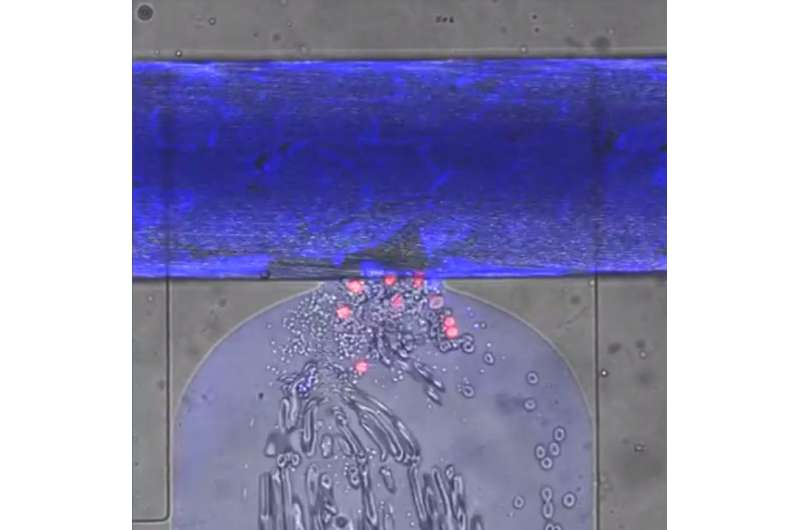Engineers create miniature self-sealing 'wound'

Biomedical engineers have developed a miniature self-sealing model system for studying bleeding and the clotting of wounds. The researchers envision the device as a drug discovery platform and potential diagnostic tool.
A description of the system, and representative movies, are scheduled for publication in Nature Communications.
Lead author Wilbur Lam, MD, Ph.D. says that blood clotting involves the damaged blood vessel, platelets, blood clotting proteins that form a net-like mesh, and the flow of the blood itself.
"Current methods to study blood clotting require isolation of each of these components, which prevents us from seeing the big picture of what's going with the patient's blood clotting system," says Lam, assistant professor in the Department of Pediatrics at Emory University School of Medicine and in the Wallace H. Coulter Department of Biomedical Engineering at Georgia Tech and Emory University.
The model is the result of a collaboration between Lam's group at Emory and Georgia Tech and Shawn Jobe, MD, Ph.D. at the Blood Center of Wisconsin. The co-first authors of the paper are research specialist Yumiko Sakurai, instructor Elaissa Hardy, Ph.D. and senior engineer Byungwook Ahn, Ph.D., now at LG Electronics.
The system is the first to reproduce all the aspects of blood vessel injury seen in the microvasculature: blood loss due to trauma, clot formation by whole blood and repair of the blood vessel lining. Previous models might only simulate clot formation, for example. The model does not include smooth muscle and does not reproduce aspects of larger blood vessels, however.
The system consists of a layer of human endothelial cells, which line blood vessels, cultured on top of a pneumatic valve. The "wound" is created by activating a pneumatic valve, opening what Lam calls a trap door. Donated human blood flows through the wound, which is about 130 micrometers across.
In the accompanying movie, most of the blood cells are seen as grey: erythrocytes are round grey donuts, while platelets are smaller specks. The red-stained cells are actually white blood cells. A green extracellular "glue" can be seen at the top of the wound; this is fibrin, which holds the clot together.
In real time, it takes about 8 minutes for blood flow into the wound to stop. Without the endothelial cells, the blood flow does not stop.
The system responds to manipulation by drugs and other alterations that reproduce clotting disorders. Blood from hemophilia A patients form abnormal clots and shows extended bleeding time in the model.
In the Nature Communications paper, the authors also describe insights into how the drug eptifibatide affects the interactions of platelets and other cells in the 3-D space of a wound.
More information: Yumiko Sakurai et al. A microengineered vascularized bleeding model that integrates the principal components of hemostasis, Nature Communications (2018). DOI: 10.1038/s41467-018-02990-x




















